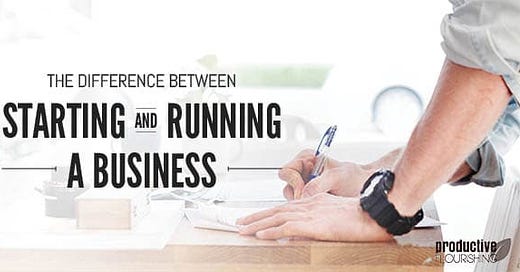The Difference Between Starting And Running A Business
The activities you need to do to start your business are different than the activities you need to do to run your business after it's already in flight. Too many business owners understand this far too late and often put the cart before the horse.
For instance, let's recall the four key dimensions of business: strategy, operations, marketing, and finance. When a business is starting out, the two areas that are generally the weakest are strategy and marketing. While there are operational and financial concerns that need to be attended to, the truth of the matter is that most early-stage businesses don't have the information they need to make good decisions about the types of operational systems and processes they need, and their financial metrics haven't reached the level of complexity that they need a sophisticated system to track.
What To Focus On When You're Getting Started
I'm not being hyperbolic when I say that most early Stage 1 businesses - especially solopreneurial ones - can make it just fine with paper, spreadsheets, and simple applications in the operations and finance dimensions. As your business needs and workflows emerge, you can develop the right systems to handle them, but in the beginning, you need to be competitive and get customers - which means you need strategy and marketing more than just about everything else.
Sidebar: of the two, marketing is much easier to sell, and we've been conditioned to think that marketing = money. The felt need and perceptions are what accounts for the fact that 80% of the information created for small businesses is about marketing and sales. Given the contextual nature, high-level, and lack of clear answers that general discussions of strategy yield, it's harder to create something that satisfies the needs of a broad audience and it's not something people wake up in the morning worrying about. Many a small business owner has woken up in the middle of the night worrying about their revenue (sales). Businesses that serve other businesses know this and take the route that's the most profitable.
When you look at the behavior of many new small business owners - especially solopreneurial ones with online businesses - you see a lot of messing around with apps, systems, plugins, folder-labeling, and activities that distract them from what needs to be happening: hitting the streets and getting customers. The only way you know whether your strategy and marketing works is if you get out there in the wild and continually tweak and refine it until it works. As Patton said, "No plan survives first contact," and in business, you've got to make the contact.
What To Focus On Once You're Moving
The scales flip at a certain point, though, when a business reaches later Stage 2. A lot of the conditions that get businesses stuck in Stage 3 have to do with the lack of an engine under the hood. Though their business may be running pretty fast, they're often propelled by the Flintstone engine - the only thing that's keeping it going is someone's feet pushing it under the floorboard.
It's at this stage of business that you have the data about what type of operational systems and processes you need. And the information you need to make better decisions about cashflow, profit centers, and cost centers lay not in what you think they are but what the financial data shows you. To get that information, you have to have a better financial system in place.
And then there are taxes. I've met few people who've made it through Stage 2 without having a significant tax surprise. That surprise could be the tax bill or the recognition that it takes forever to do your taxes with a hodgepodge of spreadsheets and receipts. Right when that business should be getting ready for the spring sales season, their operations are tied up in getting taxes done - and their revenue is often paid out to unaccounted for taxes. (Yep, we've been there, too.)
At this later stage of business, continuing to market and bring in new revenue without addressing the operational and financial side of the business is only creating a bigger bomb that's waiting to explode. Aside from the general complexity in coming up with doing the type of business optimization and formulation we're talking about here, the reasons they aren't getting done have to do with the fact that it's not a fun process and the executives within the business have habituated a sales-only focus.
So Now What?
In one of the many discussions we've had about the direction and substance of the book, Janet mentioned something along the lines of "Charlie, it's like you walk around with this entire toolset and know which levers to push and fix in a business to get it growing and running right." That was fairly accurate - but the reality is that every business consultant worth their salt can do the same thing. Combining the four dimensions of business and the business lifecycle, it's relatively simple to figure out what needs to happen. You at least know where to start fixing and optimizing, as well as knowing which things to leave alone.
As much as I wish I could tell you what to work on and how to fix it right now, the reality is that it's nothing I can do in one article. It'll take a book to do it right. :p
Examine your business. Are you focusing on the right dimension given the stage of your business? What one key lever do you need to push to get new and better results?





